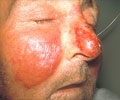Risk of severe disease in H1N1 pandemic influenza may be predicted by phe presence of the Streptococcus pneumoniae in samples that can be easily obtained in clinics and emergency rooms.
Reports that H1N1 pandemic influenza in Argentina was associated with higher morbidity and mortality than in other countries led investigators in the Center for Infection and Immunity (CII) at the Mailman School of Public Health of Columbia University, their colleagues at Argentina's National Institute of Infectious Diseases (INEI), and Roche 454 Life Sciences to look for viral mutations indicative of increased virulence and for co-infections that could contribute to disease.Complete genome sequencing of nasopharyngeal samples representing severe or mild disease revealed no evidence of evolution toward a more virulent phenotype or development of antiviral resistance. However, MassTag PCR, a method for sensitive, simultaneous surveillance and differential diagnosis of infectious diseases, found a strong correlation between the presence of Streptococcus pneumoniae and increased risk for severe disease. The findings, which suggest a new strategy for identifying and treating these patients, are currently online in the publication Plos One.
The scientists examined nasopharyngeal samples representing 199 cases of H1N1 pandemic (H1N1pdm) influenza virus infections from Argentina. The sample set included 39 cases classified as severe and 160 cases categorized as mild. "We used a combination of 454 pyrosequencing and classical Sanger sequencing methods to test for viral evolution toward increased virulence. Comparison of viral sequences from Argentina with those obtained from other parts of the world provided no clues to the increase in severity of disease," said Gustavo Palacios, PhD, assistant professor of epidemiology at CII, and a lead and corresponding author. "However, MassTag PCR allowed us to find a new risk factor, independent of obesity, asthma, diabetes or chronic illness. S. pneumoniae was present in the majority of severe cases."
Specimens were tested for the presence of 33 viral and bacterial respiratory pathogens. "The presence of Streptococcus pneumoniae in individuals between the age of 6 and 55, those most affected by the current pandemic, was associated with a 125-fold increased risk of severe disease," said Mady Hornig, MD, associate professor of epidemiology and a co-first author of the paper. "Whereas the association of S. pneumoniae with morbidity and mortality had been established in current and previous influenza pandemics, this study is the first to demonstrate that the diagnosis of S. pneumoniae, when it is still actionable, might have an impact on clinical management."
"Three practical implications emerge from our study," said CII Director W. Ian Lipkin, MD, John Snow Professor of Epidemiology, and professor of Neurology and Pathology at Columbia University. "First, S. pneumoniae is important in the pathogenesis and prognosis of H1N1pdm-associated disease. Whether this effect is associated with all S. pneumoniae or only with specific serotypes remains to be determined. Second, easily accessible samples such as nasopharyngeal swab samples may be used as an index to risk of severe disease. Third, multiplex diagnostic methods like MassTag PCR can enable rapid detection of a broad spectrum of viral and bacterial agents and inform clinical care."
Advertisement
RAS












